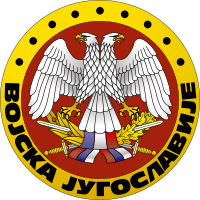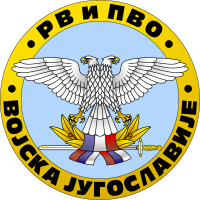Armed Forces of Serbia and Montenegro
| Armed Forces of Serbia and Montenegro Yugoslav Army | |
|---|---|
| Војска Србије и Црне Горе / Vojska Srbije i Crne (2003–2006) Војска Југославије / Vojska Jugoslavije (1992–2003) | |
 Serbia and Montenegro Armed Forces' seal | |
| Founded | May 20, 1992 (as the Yugoslav Army) |
| Current form | Serbian Armed Forces Armed Forces of Montenegro |
| Disbanded | June 5, 2006 |
| Service branches | |
| Headquarters | Belgrade, Serbia, Serbia and Montenegro |
| Leadership | |
| President | |
| Prime Minister | |
| Minister of Defence | |
| Chief of the General Staff | |
| Personnel | |
| Military age | 19 |
| Conscription | Yes |
| Active personnel | 114,000 (1999) |
| Reserve personnel | 400,000 (1999) |
| Related articles | |
| History |
|
| Ranks | Ranks and insignia of Serbia and Montenegro |
The Armed Forces of Serbia and Montenegro (
Upon the dissolution of Serbia and Montenegro with the
Organization
VJ
The Armed Forces of Yugoslavia (VJ) was organized into the following:
Ground Forces
- 1st Army
- Novi Sad Corps
- Belgrade Command
- Kragujevac Corps
- Independent units
- 2nd Army
- Podgorica Corps
- Užice Corps
- Independent units
- 3rd Army
- Niš Corps
- Leskovac Corps
- Priština Corps
- Independent units
- War Command
- Flotilla
- 81st
- 83rd
- 85th
- 108th
- 110th
- 82nd
- 69th
- 367th
- 9th
- 10th
- 27th
- 61st
- 223rd
- 9th
Air Force
VSCG
Ground Forces
Inventory

Ground Forces
- Armoured vehicles
- Artillery
- Air Defence
- Bofors 40 mm gun L/70
- M53/59 Praga – 100–200
- SA-7
- SA-14
- SA-18
- SA-9
- SA-13
- SA-3
- SA-6
- Infantry weapons
- CZ-99Pistol 9 mm
- M70A/M70B1Assault Rifles 7.62 mm
- M93 Black ArrowLong Range Rifle
- BGA
- M76 7.9 mm Sniper rifle
- M72 7.62 mm Machine gun
- M84 7.62 mm Machine gun
- M87 12.7 mm Heavy Machine gun[3]
- AT-3 Sagger
- AT-4 Spigot
- M79 "Osa"90 mm
- M80 "Zolja"64 mm rocket grenade launcher
Air Force
The inventory included
| War Navy of the Army of Yugoslavia (1992–2003) War Navy of Serbia and Montenegro (2003–2006) | |
|---|---|
| Ратна морнарица Војске Југославије (1992–2003) Ратна Морнарица Србије и Црне Горе (2003–2006) | |
 Emblem of the Navy from 1992 to 2003 | |
| Active | May 1992 – June 2006 |
| Country | |
| Garrison/HQ | Kotor, Montenegro, Serbia and Montenegro |
| March | "Mi smo ratna mornarica!" (English: "We are the War Navy!")[4] |
| Insignia | |
| Ensign |  |
| Jack |  |
The Navy, officially called the War Navy of the Army of Yugoslavia (
- Koni-class frigate(2)
- Kotor-class frigate(2)
- Heroj-class submarine (3)
- Sava-class submarine (2)
- Una-class submarine (5)
- Končar-class missile boat (6)
- Osa class missile boat(10)
- Jadran sailboat
- Neštin class minesweeper (7)
- Kozara river ship
Intelligence
- Security Administration
Operational experience
- Croatian War and Bosnian War(1992–1995), unofficially, logistical support and supplies
- Insurgency in Kosovo(27 May 1995 – 28 February 1998), belligerent, counter-terrorism
- Kosovo War (28 March 1998 – 11 June 1999), including NATO bombing of Yugoslavia (23 March – 10 June 1999), belligerent
- Insurgency in the Preševo Valley (12 June 1999 – 1 June 2001), belligerent, counter-terrorism
Statistics

Civilians fit for military service were estimated at about 4,888,595 (2001 est.). The 2002 estimate for military expenditures as percent of GDP was 4.6%. Significant reforms were undertaken in the military of Serbia and Montenegro. In 2002 the Serbo-Montenegrin Military force numbered around 117,500 soldiers, supported by some 450,000 reserves. The 100,000 strong Army had 1,500 main battle tanks and 687 armed infantry vehicles. The Navy had 3,500 personnel, of whom 900 were marines. The entire Navy was composed totally out of 6 submarines, 3 frigates, 41 patrol & coastal ships and 14 "other" vessels. The Air force 14,000 personnel had 192 combat aircraft and 72 armed helicopters.
Branches
- Army or Ground Forces (Kopnena vojska – KoV VSCG)
- Air Force and Air Defense (Ratno Vazduhoplovstvo i Protivvazdušna odbrana – RV i PVO VSCG)
- Navy (Ratna Mornarica – RM VSCG)
Military manpower – military age: 19 years of age (2003 est.)
Military manpower – availability:
males age 15–49: 3,579,620 (2003 est.)
Military manpower – fit for military service:
males age 15–49: 3,077,660 (2003 est.)
Military manpower – reaching military age annually:
males: 101,547 (2003 est.)
Military expenditures – dollar figure: $954 million (2002)
Military expenditures – percent of GDP: 4.6% (2002. est.)
International deployment
The VJ was in Croatia until October 20, 1992.[10]
The VSCG was part of
Last chief of staff of the Military of Serbia and Montenegro was general Ljubiša Jokić.
See also
- Armed Forces of Montenegro
- Serbian Armed Forces
- Yugoslav People's Army
- Destruction of Albanian heritage in Kosovo
References
- ^ Biljana Vankovska (2000). "Civil-Military Relations in the Third Yugoslavia" (working paper). Copenhagen Peace Research Institute. Archived from the original on 9 May 2022. Retrieved 15 May 2022 – via Columbia University.
- ISBN 0-300-08507-9.
JNA (now simply called the Yugoslav Army)
- ^ "Arsenal" magazine, 15 October 2007 Archived 26 March 2009 at the Wayback Machine (in Serbian)
- ^ "Yugoslavian Navy March | Mi smo ratna mornarica! | We are war navy!". YouTube.
- ISBN 9780160392757.
- ISBN 9781136713163.
- ISSN 0362-4331. Retrieved 2023-03-21.
- ISSN 0362-4331. Retrieved 2023-03-21.
- ^ "UAV REMAINS IN YUGOSLAVIA". yumodelclub.tripod.com. Retrieved 2023-03-21.
- ^ "Last Yugoslav army troops withdrawing from Croatia". UPI.
External links
- Yugoslav Ground Forces
- Serbian and Montenegrin Armed Forces / Vojska Srbije i Crne Gore – VSCG
- Army of Yugoslavia / Vojska Jugoslavije
- The Great Secret of Serbian Military Affair, which covers the time when Serbia and Montenegro was in the state union
- Encyclopedia of the Nations


